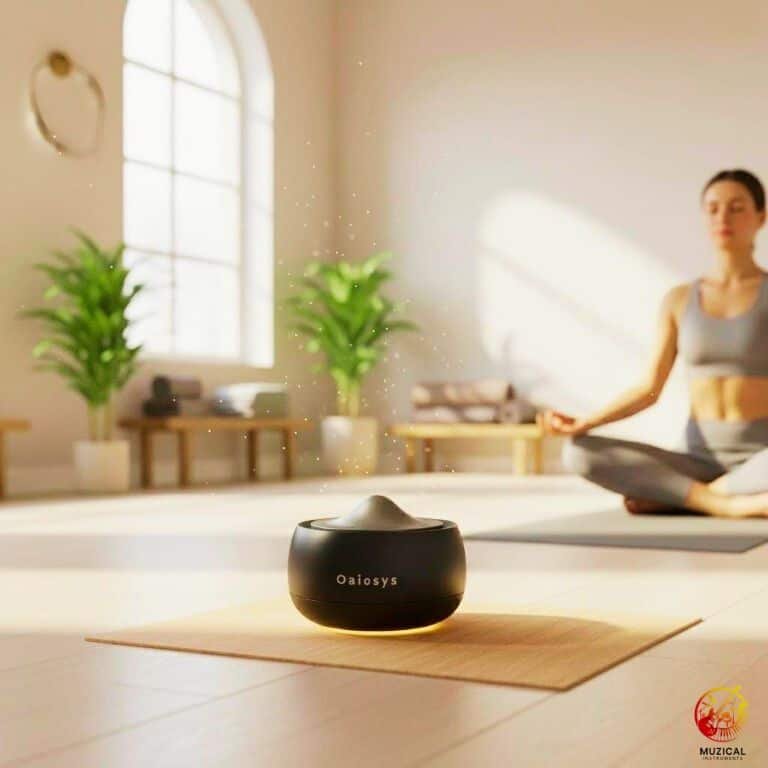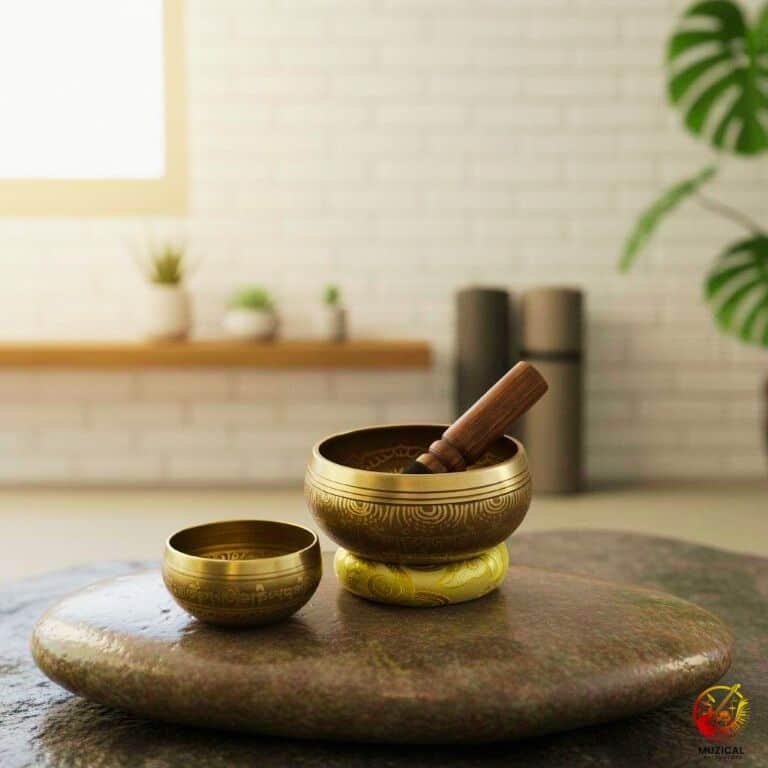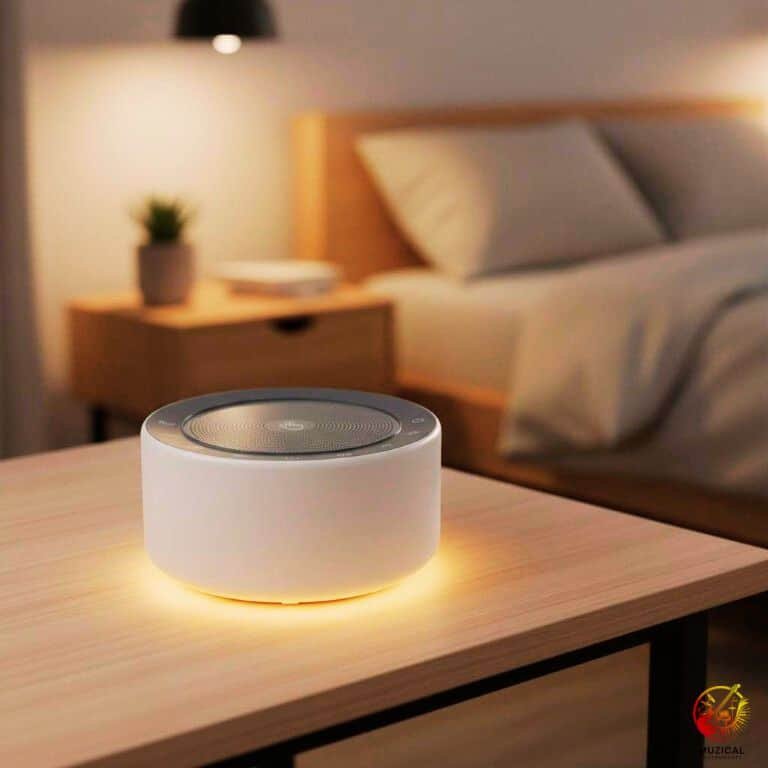Electronic vs Traditional Tibetan Singing Bowls: Which One Fits Your Practice?
Electronic vs traditional Tibetan singing bowls represent two very different paths in sound healing and meditation. Traditional bowls, made from metal alloys and played by hand, have been used for centuries in monasteries and healing practices.
Electronic versions, on the other hand, bring modern convenience with digital recordings and pre-programmed tones that mimic the original sounds.
This choice matters more than you think. If you’re building a meditation practice, leading yoga sessions, or exploring vibrational therapy, the type of bowl you use shapes your experience. Traditional bowls give you tactile resonance and heritage, while electronic ones bring portability and modern convenience.
In this guide, you’ll learn the differences between electronic vs traditional Tibetan singing bowls, their healing effects, their cultural roles, and how each fits into today’s wellness lifestyle. By the end, you’ll know which type or combination matches your purpose best.
What is the difference between electronic vs traditional Tibetan singing bowls?


The difference starts with how the sound is made. Traditional Tibetan singing bowls are crafted from a blend of metals often called a “seven metal alloy” and played with a wooden or suede mallet. When you strike or rub the rim, the bowl vibrates and produces a complex tone with layered harmonics. Each bowl is unique, shaped by its size, thickness, and the skill of the artisan.
Electronic bowls, however, don’t use metal at all. They work through digital recordings or sound synthesis. Apps, portable devices, and sound therapy software can generate the tones of traditional bowls at the push of a button.
The sound may be nearly identical to the ear, but it lacks the physical vibration you feel in your body when near a real bowl.
| Feature | Traditional Bowl | Electronic Bowl |
|---|---|---|
| Material | Hand-hammered metals | Software/device |
| Sound | Acoustic vibration | Digital playback |
| Variability | Each bowl unique | Pre-recorded, standardized |
| Portability | Heavy, fragile | Lightweight, travel-friendly |
| Energy | Physical resonance felt | Sound-only experience |
So while both options can help you in mindfulness practice, sound meditation, or chakra alignment, one is rooted in centuries of tradition, while the other is designed for modern accessibility.
Do electronic singing bowls provide the same healing benefits?


This is one of the most asked questions about electronic vs traditional Tibetan singing bowls. The short answer: not entirely.
Healing with traditional bowls works on two levels: sound and vibration. When a metal bowl resonates, you don’t just hear it, you feel it. The vibrations pass through your hands, your chest, and even the floor if the bowl is large enough. This direct resonance is why practitioners use bowls in vibrational therapy, Reiki sessions, and chakra balancing.
Electronic bowls, by contrast, deliver only the sound. While the tones can still calm your nervous system and support mindfulness, they don’t send waves through your body in the same way.
Think of the difference between listening to live drumming versus a recording, you hear the rhythm in both, but only live drumming makes your chest vibrate.
That said, research in music therapy and neuroscience shows that even recorded sounds can reduce stress hormones, improve focus, and guide the brain into meditative states. So electronic bowls remain effective for relaxation and guided meditation.
Pro Tip: If your goal is stress relief or quick daily meditation, electronic bowls work well. But if you’re interested in energy healing or somatic therapy, traditional bowls still hold the edge.
Why are traditional Tibetan singing bowls seen as more authentic?
Authenticity is tied to heritage, craft, and ritual use. Traditional Tibetan singing bowls are still made in regions like Nepal and India, where artisans hammer metal alloys by hand. The process often involves chanting or prayers, imbuing the instrument with cultural and spiritual meaning. Each bowl has a distinct “voice,” something digital technology can only copy, not create.
Monks and spiritual teachers use these bowls for meditation, chanting, and ceremonial offerings. The authenticity comes not only from the sound but from the context, centuries of use in Buddhist monasteries, Himalayan healing traditions, and shamanic practices.
Electronic bowls, on the other hand, are modern tools. They might replicate tones with high fidelity, but they don’t carry the cultural weight of a hand forged bowl. To some practitioners, this makes them feel less “real,” even if they serve the same purpose in a modern meditation class.
| Aspect | Traditional Bowl | Electronic Bowl |
|---|---|---|
| Craft | Hand-forged, unique | Mass-produced digital |
| Cultural roots | Buddhist and Himalayan traditions | Modern wellness adaptation |
| Energy | Vibrations + sound | Sound-only |
| Symbolism | Spiritual tool | Meditation aid |
If you care about spiritual lineage or wish to honor Buddhist traditions, traditional bowls are the natural choice. But if you’re approaching sound meditation primarily as a wellness practice, authenticity may be less critical.
Are electronic bowls better for modern lifestyles?
For many, yes. Electronic vs traditional Tibetan singing bowls highlights a key trade-off: convenience. A traditional bowl is heavy, fragile, and requires skill to play smoothly. An electronic bowl or even an app on your phone lets you carry multiple tones in your pocket.
This practicality is especially useful for:
- Travelers who want meditation on the go
- Yoga instructors who need long, steady tones in class
- Office workers who want a quick stress-relief break
- Students who don’t yet want to invest in expensive handcrafted bowls
Another benefit is variety. Electronic bowls can replicate multiple pitches and sizes, something you’d need a full collection of traditional bowls to achieve. With digital tools, you can access 432 Hz tones, chakra specific frequencies, or layered soundscapes at will.
The trade off, of course, is depth. Electronic bowls don’t provide tactile resonance or the same ritualistic feel.
Still, for fast paced lifestyles where meditation time is short, their portability and flexibility can outweigh the loss of physical vibration.
Expert Insight: Think of it as choosing between streaming music and playing vinyl. Streaming is portable and flexible, while vinyl has warmth and presence. Both work, the choice depends on your lifestyle.
Can electronic and traditional Tibetan bowls be used together?
Yes and combining them can create a more complete experience. Many meditation teachers, wellness coaches, and sound therapists use both to balance authenticity with convenience.
For instance, you might begin a session by striking a traditional bowl to set intention and engage the body. Once participants are grounded, you can switch to electronic tones to sustain the atmosphere. This avoids fatigue from continuous playing and ensures steady sound during group sessions.
Another use is layering. Traditional bowls provide organic resonance, while electronic bowls add background tones or drone effects. This creates a soundscape that feels rich and immersive.
| Method | Benefit |
|---|---|
| Start with traditional, continue with electronic | Combines tactile vibration with steady digital tones |
| Layering sounds | Builds complex soundscapes for deep meditation |
| Practice aid | Beginners use electronic to train their ear before investing |
| Group classes | Reduces fatigue for instructors, enhances flow |
By seeing electronic and traditional bowls as complementary rather than competing, you open new possibilities in your practice. This hybrid approach works especially well in yoga studios, sound baths, or therapy settings where flexibility matters.
Which should you choose?
Choosing between electronic vs traditional Tibetan singing bowls depends on your purpose, budget, and practice style.
Go with traditional bowls if:
- You want authentic vibration for sound healing
- You care about cultural heritage and craftsmanship
- You plan to use them in Reiki, chakra work, or energy healing
- You value uniqueness each bowl has a distinct personality
Go with electronic bowls if:
- You need portability and flexibility
- You want access to multiple tones without a large investment
- You meditate in short sessions during work or travel
- You’re a beginner exploring sound therapy
| Goal | Best Option |
|---|---|
| Deep vibrational healing | Traditional bowl |
| Quick daily meditation | Electronic bowl |
| Teaching or group sessions | Both, used together |
| Budget-friendly entry point | Electronic bowl |
| Collecting or spiritual lineage | Traditional bowl |
Pro Tip: You don’t need to commit to one forever. Many people start with electronic bowls for affordability, then invest in traditional bowls as their practice deepens. Others combine the two, using tradition for depth and electronics for daily ease.
Ultimately, the “right” choice is the one that aligns with your lifestyle and spiritual goals.
Final Thoughts
Electronic vs traditional Tibetan singing bowls offer two paths to meditation and healing. Traditional bowls bring cultural depth, tactile vibration, and spiritual authenticity. Electronic bowls deliver convenience, portability, and flexibility for modern living.
If your focus is vibrational therapy, chakra balancing, or honoring Buddhist traditions, a handcrafted metal bowl is unmatched.
If your goal is daily stress relief, travel-friendly meditation, or affordable entry into sound healing, electronic bowls can meet your needs.
Many practitioners use both, blending authenticity with practicality.
Reflect on your goals, try both formats if you can, and notice which resonates with your body and spirit. The best singing bowl is the one that truly supports your journey.
FAQ: Electronic vs Traditional Tibetan Singing Bowls
1. Are electronic Tibetan singing bowls good for meditation?
Yes. Electronic Tibetan singing bowls are very effective for meditation. They provide calming tones that help you relax, focus, and practice mindfulness anywhere. While they don’t create body vibrations like traditional bowls, they still support mental clarity and stress relief.
2. Do traditional Tibetan singing bowls really heal?
Traditional Tibetan singing bowls are widely used in sound healing because their vibrations can be felt through the body. Many practitioners believe these vibrations help balance energy, reduce stress, and support chakra alignment. While scientific evidence is still growing, many users report deep relaxation and improved well-being.
3. Can electronic and traditional bowls be used together?
Yes. You can use electronic and traditional Tibetan singing bowls in the same session. For example, start with a traditional bowl to feel the vibration in your body, then continue with electronic tones to keep the soundscape going. This blend works well for both personal and group meditation.
4. Which is better for beginners, electronic or traditional bowls?
For beginners, electronic bowls can be easier because they don’t require technique. You can simply press play and focus on meditation. Traditional bowls, however, offer a deeper experience once you’re ready to learn how to play them properly. Many people start with electronic and later move to traditional.
5. Are electronic singing bowls cheaper than traditional ones?
Yes. Electronic singing bowls are usually more affordable. You can use apps or portable devices at a low cost. Traditional bowls are handcrafted from metal and often more expensive, but they also last a lifetime and carry cultural value.
6. Do electronic bowls help with chakra alignment?
Electronic bowls can help with chakra meditation by playing tones that match specific frequencies. However, they don’t produce the same body-level vibrations as traditional bowls, which are often preferred for deeper energy work and chakra balancing.
7. Why are traditional Tibetan singing bowls considered more authentic?
Traditional bowls are handmade from metal alloys and used for centuries in Tibetan culture and Buddhist rituals. Each bowl is unique and produces vibrations that support vibrational therapy. Electronic bowls replicate these sounds but lack the cultural and tactile authenticity.
8. How do I choose between electronic vs traditional Tibetan singing bowls?
Think about your purpose. If you want convenience, portability, and affordability, electronic bowls are a good choice. If you’re seeking authentic resonance, cultural connection, and body-level healing, traditional bowls are better. Some people use both to balance modern practicality with ancient tradition.
